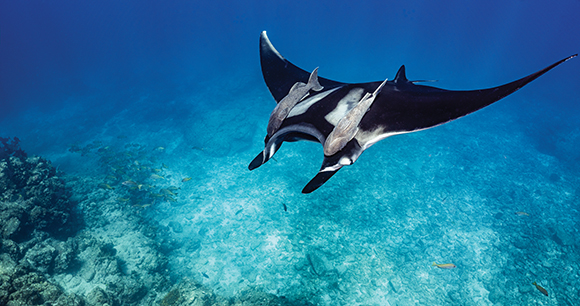Ray Surveys in the Mesoamerican Reef
by Dr. Rachel Graham, MarAlliance
Tropical rays occupy important roles in benthic ecosystems, as their foraging behaviors contribute to soft sediment turnover, which makes food available and creates microhabitats for other species. The Mesoamerican Reef (MAR), from the northern tip of the Isla Contoy in Mexico to the Bay Islands of Honduras, hosts at least 11 coastal-pelagic species of rays—including the Caribbean manta, Caribbean whiptail, cownose, giant manta (shown below), lesser electric, longnose, sicklefin devil, southern, spotted eagle, West Atlantic pygmy devil, and yellow ray. These species are economically important, in terms of fisheries in Mexico and Guatemala, and ecotourism in Belize and Mexico.

With support from a Christine Stevens Wildlife Award, we analyzed previously acquired data from Mexico for several marine species, including rays, and then conducted ray assessments and built local capacities to monitor rays found in the MAR, other offshore sites, and the Belize Barrier Reef (BBR).
Using a pair of standardized noninvasive monitoring methods, including underwater visual census techniques and baited remote underwater video systems, we (including traditional fishers) carried out ray surveys to assess species diversity, distribution, and abundance. Compared to traditional survey techniques, which involve costly boat-based or scuba surveys, our methods are less expensive, cover a far larger geographic area, enable rapid sizing and sexing of animals, and allow for participation of fishers and local students who generally do not have access to scuba gear. Our regional results revealed that ray species diversity and abundance were highest in Belize, with lower relative sightings at sites in Mexico and Honduras.
The same monitoring techniques were used throughout the BBR and offshore atolls in 2022 to estimate ray species diversity and distribution and to assess changes in abundance over time. Abundance estimates varied annually, with counts of southern rays inversely associated with shark abundance. Spotted eagle ray abundance was highest at the atolls, while overall ray diversity was higher along the BBR, with lower abundance in the southern portion of the reef.
Threats to these species are primarily from bycatch and targeted gillnet fisheries. Though consumption of ray meat in Belize was not common historically, demand for ray products has increased in neighboring countries in recent years, incentivizing illegal retention of bycaught rays in Belize. Ray meat is generally not marketed fresh in Guatemala or Honduras, but sold as salted fish that is consumed locally. Fishing mortality has led to a lower abundance of rays in Mexico and southern Belize.
The regional and Belize-based ray assessments, made possible by the award, represent the first comprehensive study of tropical rays, their distribution, and threats in Mesoamerica. Established and emerging fisheries for these species remain unregulated. Moving forward, multinational conservation measures that build on Belize’s recent protective legislation for rays—including the national ban on fishing nets—are needed to protect these ecosystem engineers and support coastal ray-focused ecotourism. To assess the effectiveness of the legislation in conserving and rebuilding ray populations in Belize and the larger MAR area, we will continue to employ our standardized and highly collaborative noninvasive monitoring methods.
This study was funded by the Christine Stevens Wildlife Awards program. Learn more about this program or view additional studies.
Program Terms: Marine Wildlife
AWI Quarterly Terms: Feature Article
Related News
North American Environmental Commission Confirms Mexico’s Role in Imperiling Vaquita
In Program: Marine WildlifeA commission under the United States-Mexico-Canada Trade Agreement (USMCA) released a report yesterday confirming that Mexico’s unwillingness to enforce its own wildlife protection, trade, and fisheries laws...
Captive dolphins face uncertain futures. They deserve better
In Program: Marine WildlifeIn this op-ed for the Tampa Bay Times, Dr. Naomi Rose, AWI’s senior scientist in marine mammal biology, discusses the challenges in caring for orcas...
Yahoo! Japan Sells Polluted Whale and Dolphin Meat Products to Unsuspecting Consumers
In Program: Marine WildlifeThe Animal Welfare Institute (AWI) and an international coalition of animal protection and environmental groups are calling on Yahoo! Japan and its parent company, the...
As Iceland Calls Off Fin Whale Slaughter, Japan and Norway Launch Cruel, Unsustainable Whale Hunting Seasons
In Program: Marine WildlifeJapan and Norway resumed slaughtering whales this month, while Iceland’s only fin whaling company has decided that it will not hunt this summer, citing a...